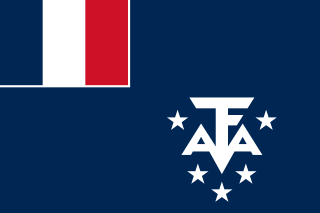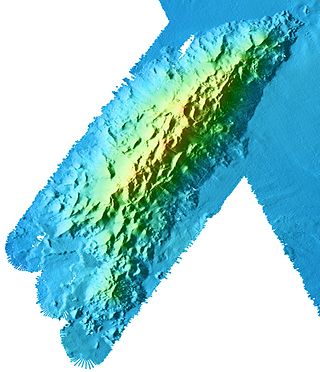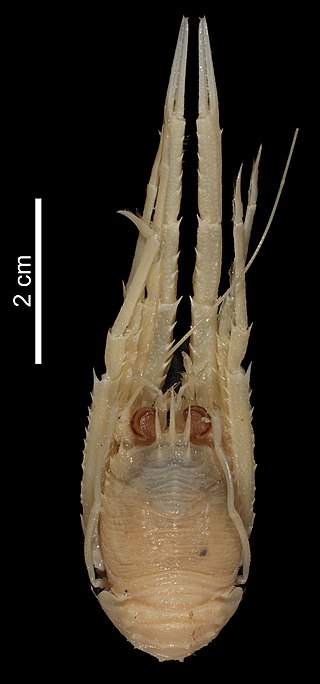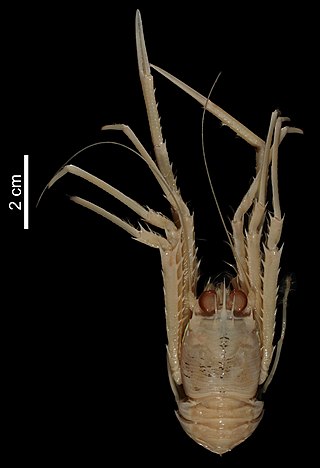
The French Southern and Antarctic Lands is an overseas Territory of France. It consists of:
- Adélie Land, the French claim on the continent of Antarctica.
- Crozet Islands, a group in the southern Indian Ocean, south of Madagascar.
- Kerguelen Islands, a group of volcanic islands in the southern Indian Ocean, southeast of Africa.
- Saint Paul and Amsterdam Islands, a group to the north of the Kerguelen Islands.
- Scattered Islands, a dispersed group of islands around the coast of Madagascar.

The Mariana Trench is an oceanic trench located in the western Pacific Ocean, about 200 kilometres (124 mi) east of the Mariana Islands; it is the deepest oceanic trench on Earth. It is crescent-shaped and measures about 2,550 km (1,580 mi) in length and 69 km (43 mi) in width. The maximum known depth is 10,984 ± 25 metres at the southern end of a small slot-shaped valley in its floor known as the Challenger Deep. The deepest point of the trench is more than 2 km (1.2 mi) farther from sea level than the peak of Mount Everest.

The United States Fish and Wildlife Service is an agency within the United States Department of the Interior dedicated to the management of fish, wildlife, and natural habitats. The mission of the agency is "working with others to conserve, protect, and enhance fish, wildlife, plants and their habitats for the continuing benefit of the American people."

Hevea brasiliensis, the Pará rubber tree, sharinga tree, seringueira, or most commonly, rubber tree or rubber plant, is a flowering plant belonging to the spurge family Euphorbiaceae originally native to the Amazon basin, but is now pantropical in distribution due to introductions. It is the most economically important member of the genus Hevea because the milky latex extracted from the tree is the primary source of natural rubber.

The Pearl and Hermes Atoll, also known as Pearl and Hermes Reef, is part of the Northwestern Hawaiian Islands, a group of small islands and atolls that form the farthest northwest portion of the Hawaiian island chain. The atoll consists of a variable number of flat and sandy islets, typically between five and seven. More were noted in historical sources but have since been lost to erosion and rising sea levels.

Kaikō was a remotely operated underwater vehicle (ROV) built by the Japan Agency for Marine-Earth Science and Technology (JAMSTEC) for exploration of the deep sea. Kaikō was the second of only five vessels ever to reach the bottom of the Challenger Deep, as of 2019. Between 1995 and 2003, this 10.6 ton unmanned submersible conducted more than 250 dives, collecting 350 biological species, some of which could prove to be useful in medical and industrial applications. On 29 May 2003, Kaikō was lost at sea off the coast of Shikoku Island during Typhoon Chan-Hom, when a secondary cable connecting it to its launcher at the ocean surface broke.

The New Guinea big-eared bat or Papuan big-eared bat,, is a vesper bat endemic to Papua New Guinea. It is listed as a critically endangered species due to ongoing habitat loss. It is the only known member of the genus Pharotis, which is closely related to Nyctophilus.

The Great Pacific garbage patch is a garbage patch, a gyre of marine debris particles, in the central North Pacific Ocean. It is located roughly from 135°W to 155°W and 35°N to 42°N. The collection of plastic and floating trash originates from the Pacific Rim, including countries in Asia, North America, and South America.

Ulmus alata, the winged elm or wahoo, is a small- to medium-sized deciduous tree endemic to the woodlands of the southeastern and south-central United States. The species is tolerant of a wide range of soils, and of ponding, but is the least shade-tolerant of the North American elms. Its growth rate is often very slow, the trunk increasing in diameter by less than 5 mm per year. The tree is occasionally considered a nuisance as it readily invades old fields, forest clearings, and rangelands, proving particularly difficult to eradicate with herbicides.

Davidson Seamount is a seamount located off the coast of Central California, 80 mi (129 km) southwest of Monterey and 75 mi (121 km) west of San Simeon. At 26 mi (42 km) long and 8 mi (13 km) wide, it is one of the largest known seamounts in the world. From base to crest, the seamount is 7,480 ft (2,280 m) tall, yet its summit is still 4,101 ft (1,250 m) below the sea surface. The seamount is biologically diverse, with 237 species and 27 types of deep-sea coral having been identified.

Agononida is a genus of squat lobsters in the family Munididae. In 2022, recognizing that the genus as then defined was paraphyletic, it was divided into three lineages: Agononidasensu stricto and two new genera, Garymunida and Hexamunida. Agononida is distributed in the Indian and Pacific Oceans.

iNaturalist is an American 501(c)(3) nonprofit social network of naturalists, citizen scientists, and biologists built on the concept of mapping and sharing observations of biodiversity across the globe. iNaturalist may be accessed via its website or from its mobile applications. iNaturalist includes an automated species identification tool, and users further assist each other in identifying organisms from photographs. As of 17 June 2023, iNaturalist users had contributed approximately 161,278,660 observations of plants, animals, fungi, and other organisms worldwide, and around 350,000 users were active in the previous 30 days.

Agononida africerta is a species of squat lobster in the family Munididae. The species name is a combination of Africa and the Latin word incerta, the feminine version of the word incertus, meaning "doubtful".

Agononida auscerta is a species of squat lobster in the family Munididae. The species name is a combination of Australia and the Latin word incerta, the feminine version of the word incertus, meaning "doubtful".
Agononida incerta is a species of squat lobster in the family Munididae. It is found from Taiwan and the Philippines to southern Western Australia, ranging from 280 to 460 metres in depth. The males usually measure from 7 to 38 millimetres and the females from 7.5 to 21 millimetres. It forms a species complex with A. africerta, A. auscerta, A. indocerta, A. norfocerta, A. madagascerta, A. polycerta, A. tasmancerta, A. vanuacerta, and A. rubrizonata.

Agononida marini is a species of squat lobster in the family Munididae. The species name is dedicated to Marin Manriquez. The males measure from 7.8 to 26.8 millimetres and the females from 6.5 to 25 millimetres. It is found off of New Caledonia, Loyalty Islands, Chesterfield Islands, eastern Australia, and northern New Zealand, at depths between about 460 and 600 metres.

Agononida polycerta is a species of squat lobster in the family Munididae. It can be found in French Polynesia.
Garymunida soelae is a species of squat lobster in the family Munididae. The species is named for the research vessel Soela, which is the vessel on which the type specimen was collected. The males measure about 28.2 millimetres (1.11 in) and the females about 14.1 millimetres (0.56 in). It is found off of Indonesia, northwestern Australia, and New Caledonia, at depths between 450 and 620 metres. It is also found off of Fiji, where it resides between depths of about 680 and 725 metres.

Syracosphaera azureaplaneta is a species of coccolithophore. This oceanic phytoplankton is not common, but is widely distributed and is known to occur in all the major seas, from tropical to sub-arctic regions. It is named after the BBC TV documentary series, The Blue Planet.
Uniporus is a genus of worms belonging to the monotypic family Uniporidae.

















